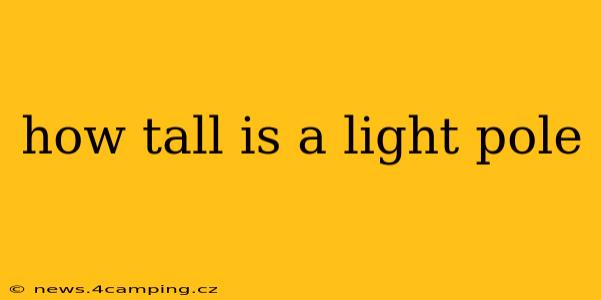The height of a light pole isn't a one-size-fits-all answer. It varies dramatically depending on several factors, making a simple numerical response insufficient. This guide explores the typical heights, influencing factors, and common applications to give you a comprehensive understanding.
What Determines the Height of a Light Pole?
Several key factors influence the height of a light pole, resulting in a wide range of heights across different settings:
- Location: Streetlights in residential areas are typically shorter than those on highways or in large parking lots. The need for broader illumination in larger spaces requires taller poles to cast light over a wider area.
- Purpose: The intended purpose significantly impacts the height. Security lighting in a small parking lot might use shorter poles, while stadium lighting demands much taller structures for optimal field coverage.
- Mounting Type: The method of mounting—directly on the ground, on a building, or attached to a bracket—affects the overall height. Ground-mounted poles are generally taller to achieve the desired illumination level.
- Lighting Technology: The type of lighting technology used (e.g., LED, high-pressure sodium) can influence the required height. More energy-efficient LEDs often allow for slightly shorter poles while maintaining adequate illumination.
- Local Regulations: Building codes and local regulations may dictate minimum or maximum heights for light poles within specific zones or areas.
Typical Light Pole Heights: A Range of Possibilities
While there's no single definitive answer, here's a breakdown of typical heights you might encounter:
-
Residential Areas: Light poles in residential neighborhoods typically range from 10 to 15 feet (3 to 4.5 meters). These shorter poles provide adequate lighting for streets and sidewalks without being visually obstructive.
-
Commercial Areas/Parking Lots: Commercial areas and parking lots often use taller poles ranging from 15 to 25 feet (4.5 to 7.5 meters). Taller heights ensure broader illumination across larger spaces.
-
Highways and Major Roads: Highways and major roads usually require much taller poles, often reaching 30 to 50 feet (9 to 15 meters) or even higher. This greater height is crucial for providing sufficient visibility and safety for drivers.
-
Sports Stadiums and Large Venues: The tallest light poles are found in sports stadiums and large venues, sometimes reaching heights exceeding 100 feet (30 meters). These poles need to illuminate expansive areas for optimal viewing and play.
How Tall Are Different Types of Light Poles?
The type of light pole itself can also influence its height:
- Decorative Light Poles: These poles are often shorter and designed with aesthetic appeal in mind, often found in parks or historical districts.
- Streetlight Poles: These poles vary considerably in height depending on location and purpose, as discussed earlier.
- Security Light Poles: Heights for security lights typically depend on the area they're illuminating, ranging from relatively short for smaller areas to taller for larger spaces.
What are the factors that affect the lifespan of a light pole?
Several factors contribute to a light pole's lifespan:
- Material: The material used in the construction (e.g., steel, aluminum) significantly impacts durability and resistance to corrosion.
- Environmental Conditions: Exposure to harsh weather conditions (extreme temperatures, salt spray, etc.) can accelerate deterioration.
- Maintenance: Regular maintenance, including inspections and repairs, is crucial for extending the lifespan.
- Installation: Proper installation is essential to prevent structural issues that could shorten the pole's lifespan.
How much does a light pole cost?
The cost of a light pole is highly variable and depends on numerous factors, including:
- Height: Taller poles generally cost more.
- Material: Different materials (steel, aluminum, composite materials) have varying costs.
- Features: Additional features like decorative elements or specialized mounting hardware can increase the cost.
- Installation: Installation costs can vary based on location and complexity.
This comprehensive guide provides a deeper understanding of the factors influencing light pole height and offers a more nuanced perspective beyond a simple numerical answer. Remember that consulting with lighting professionals is always recommended for specific projects to ensure the optimal height and type of pole for your individual needs.
